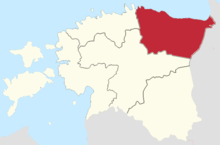Kirde-Eesti
| Languages: | |||||||||||||||||||||||||||||||||||||||||||||||||||||||||||||||||||||||||||||||||||||||
| |||||||||||||||||||||||||||||||||||||||||||||||||||||||||||||||||||||||||||||||||||||||
  | |||||
 | |||||
| |||||
Contents
Geography
Kirde-Eesti covers 3 364 km², extending from the southern shore of the Gulf of Finland in the north to Lake Peipsi in the south. The Narva River, which runs from the lake to the sea, forms the border in the east. The main natural regions are the Northeast Estonian Plateau in the north and the forested Alutaguse Area in the south. A peculiar characteristic of the landscape is the long and steep northern cliff coast, which reaches its highest point in Ontika, where the cliff rises some 56 m above sea level.
Kirde-Eesti is lacking large rivers (except the Narva River) and lakes, but Estonia's largest swamps and wooded areas are situated in the central and southern parts of the region. Forests cover 57% of Kirde-Eesti. The percentage of land occupied by mires is among the highest in Kirde-Eesti. Estonia's largest mire, Puhatu mire complex (571 km²), is situated in this region. Muraka bog (128 km²) is the second large mire in Kirde-Eesti.
There are many picturesque beaches here, 70 km along the sea coast, and 42 km along the shore of Lake Peipsi.
Location
Kirde-Eesti is neighbored by the following regions:
Resources
No resources have been discovered yet.
History
Kirde-Eesti is located in the northeastern part of Estonia and covers the part of the historic Virumaa region on the southern shores of the Gulf of Finland.The first find of a 5 000-year-old piece of pottery, the oldest ever discovered on Estonian territory, occurred on the banks of the Narva River.
The history of Kirde-Eesti is replete with battles and changes in foreign rule. At the beginning of the 13th century, German Teutonic knights conducted looting raids into Virumaa. In 1220, Kirde-Eesti was conquered and christianised by the Danes, then ruled by Germans, Swedes and Russians. At the end of the 19th century, the national movement gained strength in Kirde-Eesti. In November 1918, the War of Independence broke out with the capture of Narva by the Red Army. The January 1919 counterattack by the Estonians put an end to the Bolshevik power base at Narva and the front moved to southern Estonia. It was at Narva in 1939 that ratification of the military bases agreement put an end to the 22-year period of Estonian independence, since Soviet troops entered Estonia's territory under this agreement, and Estonia became part of the Soviet Union, remaining in it for 50 years, up to 1991. At the end of World War II, severe battles were fought in vain in the Sinimäe hills near Narva. Narva, a city of unique architectural heritage, was razed to the ground.
| Regions of |
|---|
|
Flanders · Fujairah · Kesk-Eesti · Kinki · Kirde-Eesti · Louna-Eesti · Nazareth North District · Pohja-Eesti |